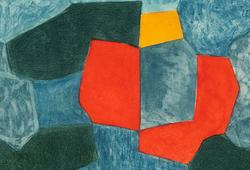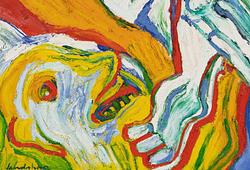Carl Larsson
”En Unge” ("A Child")
Signed, inscribed with personal dedication: "Denna enkla skiss är gjord för att derå skrifva ett varmt Tack! till C.A. Strandman! vännen" C.L. (within a circle) and dated 1916. Watercolour 45 x 23 cm.
Provenance
Originally in the collection of C. A. Strandman (owner of Fritzes Kungl. Hovbokhandel, Stockholm) as a gift directly from the artist.
Private collection.
Bukowskis Auktioner, Stockholm, Höstens Klassiska Auktion 583, 2 - 4 December 2014, lot 698.
Exhibitions
Liljevalchs konsthall, Stockholm, "Minnesutställning. Carl Larsson", 6 March - 5 April 1920, no. 322.
Literature
Ulwa Neergaard, "Carl Larsson. Signerat med pensel och penna", 1999, illustrated in colour, p. 564 and catalogued under year 1916, p. 162, no. 1667.
More information
The auction work "En unge" subtly captures the essence of what has become synonymous with Carl Larsson's artistry: the Swedish home environment, childhood, and the intimate moments of family life. Given as a personal gift to the bookseller C.A. Strandman, the work is not only an artistic expression but also a document of Larsson's close relationships and the professional network that was crucial to his success.
In "En unge", we see a small girl, light-haired and barefoot, sitting on a chair in the Anteroom at Lilla Hyttnäs, Larsson's home in Sundborn. The simple yet powerful composition, with its warm colour palette and clean lines, conveys a sense of both calm and presence. Behind the young girl, the pink walls with their green mouldings are visible, a detail that immediately evokes Karin Larsson's interior design style. On the floor lies the blue-and-white striped rag rug, and the white-painted Bellman chair with its characteristic blue checkered upholstery adds to the sense of stylistic harmony that permeated Larsson's home.
The watercolour is dedicated with a personal note: "This simple sketch is made to write a warm Thank You! to C.A. Strandman! friend." This attests to the close friendship between Larsson and Strandman, who, through his bookstore Fritzes, was an important mediator of Larsson's art. Fritzes was a channel through which Larsson reached an audience that appreciated his intimate depictions of childhood and family life.
Despite his work on the monumental piece Midvinterblot for the Nationalmuseum, Larsson often found time for the more intimate watercolours, such as "En unge." This work exemplifies his ability to transform the everyday and private into something larger and more universal. With its soft colours and simple composition, Larsson creates a timeless image of the innocent moments of childhood—a portrayal that continues to touch and fascinate.
"En unge" is not only an illustration of a moment from Larsson's family life but also an example of his place in Swedish art history. Through his interior paintings and watercolours, he was a central figure in the movement Swedish Home, where he created an idealised image of the Swedish home—a place where nature, warmth, and togetherness were in focus. This watercolour reflects this vision, where the simple and everyday acquires a special, timeless beauty.
Artist
Carl Larsson is considered one of the greatest Swedish artists of all time. He was born in Gamla Stan in Stockholm and studied at the Royal Academy of Arts in the years 1866-76. After his studies in Stockholm, he traveled to France and settled in Grèz-sur-Loing. There he mainly painted garden motifs. In France, he met his future wife Karin Bergöö, who was also an artist and came to mean a lot for his artistry. Already during his student years, he made a living as a photo retoucher and cartoonist in the press. It was also during his studies that Larsson got to know Anders Zorn and Bruno Liljefors, together the three are usually called the ABC artists. At the end of the 1880s, Carl and Karin were given "Lilla Hyttnäs" in Sundborn outside Falun by Karin's father, and this is where Larsson's most famous watercolors depicting his family were created. The motifs often depict sunny landscapes with children, crayfish fishing, meals in the green and interior scenes. Larsson is represented, among other, in the National Museum, where "Gustav Vasas intåg i Stockholm" and "Midvinterblot" fills the stairwell. Represented mainly at the National Museum in Stockholm and at the Gothenburg Art Museum.
Read more






































